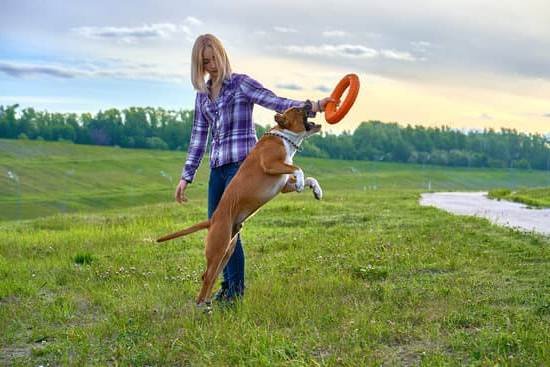Training your dog to quiet down when the doorbell rings is an essential skill for pet owners who want to maintain a peaceful and harmonious home environment. In this article, we will explore how to train your dog to be quiet when the doorbell rings in a few simple steps.
By understanding your dog’s behavior, implementing basic obedience training, using positive reinforcement, and establishing consistency, you can successfully teach your furry friend to greet visitors without barking or getting too excited.
Understanding why dogs bark at the doorbell is crucial in effectively addressing this behavior. It could be due to excitement, anxiety, or even territorial instincts. Basic obedience training lays the foundation for more advanced skills like doorbell training. Introducing the doorbell sound gradually and using positive reinforcement are key components of successful training. Additionally, it’s important to address unwanted behavior with gentle correction and redirection techniques while maintaining a consistent routine.
With dedication and patience, you can troubleshoot common challenges in doorbell training and ultimately enjoy the benefits of a peacefully trained dog when the doorbell rings. Let’s delve into the details of each step in training your dog to quietly use a doorbell for a more peaceful and enjoyable living space for both you and your four-legged friend.
Understanding Your Dog’s Behavior
When your dog barks at the doorbell, it may seem like an instinctual response, but there are a few reasons behind this behavior. One common reason is that dogs see the doorbell as an intrusion into their territory, prompting a protective or territorial response. Additionally, some dogs may bark at the doorbell due to excitement or anxiety, especially if they are not used to visitors coming over.
It’s important to understand why your dog exhibits this behavior in order to effectively train them to be quiet when the doorbell rings. By recognizing the root cause of their barking, you can address it through specific training techniques tailored to your dog’s needs, temperament, and personality.
In some cases, your dog may simply be reacting to the sound of the doorbell without understanding what it means. This lack of understanding can lead to confusion and anxiety. Therefore, it’s crucial to introduce them to the concept of the doorbell in a positive and controlled manner. This will help desensitize them to the sound and teach them how to respond calmly when it rings.
| Common Reasons for Doorbell Barking | Training Techniques |
|---|---|
| Protective or territorial response | Confidence-building exercises |
| Excitement or anxiety | Calming techniques and positive reinforcement |
| Lack of understanding | Desensitization training with gradual exposure to the sound |
Basic Obedience Training
When it comes to training your dog to be quiet when the doorbell rings, basic obedience training is essential. This foundational training will help establish a strong communication between you and your furry friend, making it easier to introduce doorbell training later on.
One of the most important aspects of basic obedience training is teaching your dog how to respond to verbal commands such as “sit,” “stay,” and “quiet.” This will give you the tools to effectively manage your dog’s behavior when the doorbell rings, ultimately leading to a quieter and more controlled response.
In addition to verbal commands, leash training is also crucial in building a well-behaved dog. By teaching your dog how to walk calmly on a leash, you can better control their excitement when someone approaches the door, leading to a quieter and more controlled reaction. Consistency and patience are key in this process, as it may take time for your dog to fully grasp these fundamental obedience skills.
| Aspect of Obedience Training | Importance |
|---|---|
| Verbal Commands (Sit, Stay, Quiet) | Establishes communication between owner and dog |
| Leash Training | Ensures calm and controlled behavior when someone approaches the door |
Introducing the Doorbell
When it comes to training your dog to respond calmly to the doorbell, desensitization is a crucial step in the process. By gradually exposing your dog to the sound of the doorbell, you can help them become less reactive and more controlled when they hear it. Here are some key tips for introducing the doorbell and desensitizing your dog:
1. Start with a low volume: Begin by playing the doorbell sound at a very low volume, so as not to startle or overwhelm your dog. You can use a recording of the actual doorbell or choose a similar sound from an app or online source.
2. Use positive reinforcement: As soon as you play the doorbell sound, observe your dog’s reaction. If they remain calm, reward them with praise and treats. This will help them associate the sound with positive experiences.
3. Gradually increase the volume: Over time, slowly increase the volume of the doorbell sound during training sessions. If at any point your dog becomes anxious or reactive, reduce the volume and go back to rewarding calm behavior.
4. Create realistic scenarios: Once your dog shows progress with low-volume doorbell sounds, simulate real-life situations by playing the sound when someone is actually at your front door. This will further help desensitize them to the noise and teach them how to behave in response.
By following these steps and being patient with your dog, you can effectively desensitize them to the doorbell sound and set them up for success in quieting their reaction when it rings.
Positive Reinforcement
When it comes to training your dog to respond quietly to the doorbell, positive reinforcement can be a powerful tool. By using treats and rewards, you can encourage your dog to associate the sound of the doorbell with good behavior, ultimately leading to a quieter and more well-behaved pet.
Here are some effective strategies for using positive reinforcement in doorbell training:
1. Treats: Use your dog’s favorite treats as a reward for quiet behavior when the doorbell rings. Each time the doorbell sounds and your dog remains calm, immediately give them a treat to reinforce the desired response. Over time, they will learn that staying quiet results in a yummy reward.
2. Verbal praise: In addition to treats, verbal praise can also be an effective form of positive reinforcement. When your dog responds quietly to the doorbell, be sure to offer plenty of enthusiastic praise and affection. This will further reinforce the desired behavior and strengthen the association between quietness and positivity.
3. Clicker training: Consider utilizing a clicker as part of your positive reinforcement strategy. The clicker can be used to mark the exact moment when your dog exhibits quiet behavior in response to the doorbell. Pairing this with treats or verbal praise will help make the connection between their actions and the reward even clearer.
By consistently employing these positive reinforcement techniques, you can effectively teach your dog that remaining quiet when the doorbell rings is a desirable behavior. With patience and consistency, you can train your furry friend to greet guests without excessive barking or excitement, creating a more peaceful and harmonious home environment for everyone involved.
Correcting Unwanted Behavior
Understanding the Root of the Behavior
Before you can effectively correct your dog’s barking and excitement at the doorbell, it’s important to understand why they exhibit this behavior in the first place. Dogs often bark and become excited at the doorbell due to their natural instinct to protect their territory.
In addition, the sound of the doorbell can be a trigger for excitement as it often signals the arrival of visitors or potential playtime. By recognizing these underlying reasons, you can tailor your training approach to address them directly.
Redirecting With Positive Reinforcement
One effective method for correcting unwanted behavior such as barking is through positive reinforcement. When your dog remains calm and quiet in response to the doorbell, immediately reward them with treats or verbal praise.
This will help them associate quiet behavior with a positive outcome, encouraging them to repeat this behavior in the future. By consistently providing positive reinforcement during doorbell training sessions, you can effectively redirect your dog’s initial instinct to bark and replace it with a more desirable response.
Implementing Alternative Behaviors
In addition to using positive reinforcement, another helpful technique for redirecting barking and excitement is implementing alternative behaviors that are incompatible with barking. For example, teaching your dog to go to a designated spot or retrieve a toy when the doorbell rings provides an alternative outlet for their energy and excitement.
By consistently practicing these alternative behaviors during doorbell training sessions, you can gradually shape your dog’s response to the sound of the doorbell from one of excessive barking to one of calm and controlled behavior.
Consistency Is Key
Regular Practice and Repetition
Training your dog to be quiet when the doorbell rings requires consistent practice and repetition. Set aside dedicated time each day to work on doorbell training with your dog. By practicing frequently, you are reinforcing the behavior you want to see from your dog and helping them understand what is expected of them when the doorbell rings.
Setting Up Realistic Expectations
It’s important to set realistic expectations for your dog when it comes to doorbell training. Understand that every dog learns at their own pace, so don’t get discouraged if progress is slow at first. Patience is key in establishing a routine for doorbell training, and remember that consistency is essential in achieving the desired outcome.
Implementing a Verbal Cue
In addition to consistent practice, implementing a verbal cue can also aid in establishing a routine for doorbell training. You can use a specific word or phrase, such as “quiet” or “enough,” to signal to your dog that they should stop barking when the doorbell rings. With regular reinforcement of this verbal cue during training sessions, your dog will learn to associate the command with quiet behavior when the doorbell sounds.
By incorporating regular practice, setting realistic expectations, and implementing a verbal cue, you can effectively establish a routine for doorbell training with your dog. Remember that patience and consistency are crucial in this process, and with dedication, you will soon enjoy the benefits of a quietly trained dog when the doorbell rings.
Troubleshooting
Training your dog to quiet down when the doorbell rings can be a challenging task, and it’s common for pet owners to encounter obstacles along the way. One of the most common challenges in doorbell training is excessive barking and excitement every time the doorbell rings. This can be frustrating not only for you but also for your guests who are greeted by an overexcited pup. So, how do you address these common challenges in doorbell training?
One common challenge in doorbell training is getting your dog to stay calm and composed when the doorbell rings. If your dog still gets overly excited or starts barking despite consistent training, try redirecting their attention with a command such as “sit” or “stay.” By teaching your dog to respond to these commands, you can help them focus on something other than the sound of the doorbell.
Another common challenge is keeping your dog from rushing towards the door as soon as they hear the bell. To address this, practice having someone ring the doorbell while you hold your dog on a leash. When they start to pull towards the door, gently tug on the leash and give a firm “no” command. With consistent practice and repetition, your dog will learn that they must remain calm when the doorbell rings.
Additionally, if your dog continues to bark excessively even after desensitization and positive reinforcement, it may be helpful to seek professional help from a certified dog trainer or behaviorist. They can provide personalized strategies and techniques based on your dog’s specific behavior and temperament, helping you overcome any remaining challenges in doorbell training.
By addressing these common challenges through patience, consistency, and possibly professional guidance, you can effectively train your dog to exhibit quiet and well-behaved behavior when the doorbell rings.
Conclusion
In conclusion, training your dog to respond quietly to the doorbell is an important skill that can greatly improve your and your pet’s quality of life. Understanding why dogs bark at the doorbell and addressing those behaviors through basic obedience training, positive reinforcement, and consistency can create a harmonious environment in your home.
By desensitizing your dog to the sound of the doorbell and using treats and rewards to encourage quiet behavior, you can enjoy a peaceful entrance without the chaos and excitement that often accompanies it.
It’s important to remember that training takes time and patience, so don’t be discouraged by setbacks along the way. Correcting unwanted behavior and establishing a routine for doorbell training will require diligence and consistency, but the benefits of a calmly trained dog at the doorbell are well worth the effort. With dedication and persistence, you can successfully teach your furry friend to greet visitors in a calm, controlled manner.
Ultimately, by investing time in properly training your dog to respond quietly to the doorbell, you can create a more welcoming environment for guests while ensuring that your furry friend is well-behaved. Incorporating these techniques into your routine can lead to less stress and frustration for both you and your dog when visitors come knocking. With patience and practice, you too can enjoy the benefits of a peacefully trained dog at the doorbell.
Frequently Asked Questions
How Do I Train My Dog to Be Quiet Despite Doorbells?
Training your dog to be quiet despite doorbells requires patience and consistency. Start by desensitizing your dog to the doorbell sound using recordings at a low volume, then gradually increase the sound. Reward your dog for staying calm as you work on this training.
How Do I Keep My Dog Calm When the Doorbell Rings?
Keeping your dog calm when the doorbell rings can be achieved through positive reinforcement and redirection. Teach your dog to go to a designated spot whenever the doorbell rings, and reward them for staying calm in that spot. Gradually increase the duration of their stay as they improve.
How to Train Your Dog to Not Bark When Someone Comes to the Door?
To train your dog to not bark when someone comes to the door, start by teaching them a “quiet” command. Use positive reinforcement to reward them for not barking when someone approaches the door, and redirect their attention with toys or treats if necessary. Consistency is key in this training process.

Welcome to the blog! I am a professional dog trainer and have been working with dogs for many years. In this blog, I will be discussing various topics related to dog training, including tips, tricks, and advice. I hope you find this information helpful and informative. Thanks for reading!





